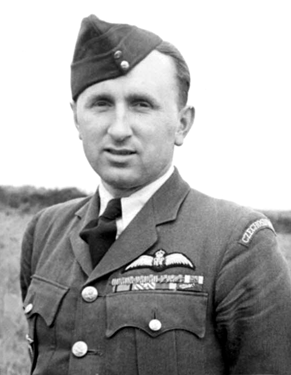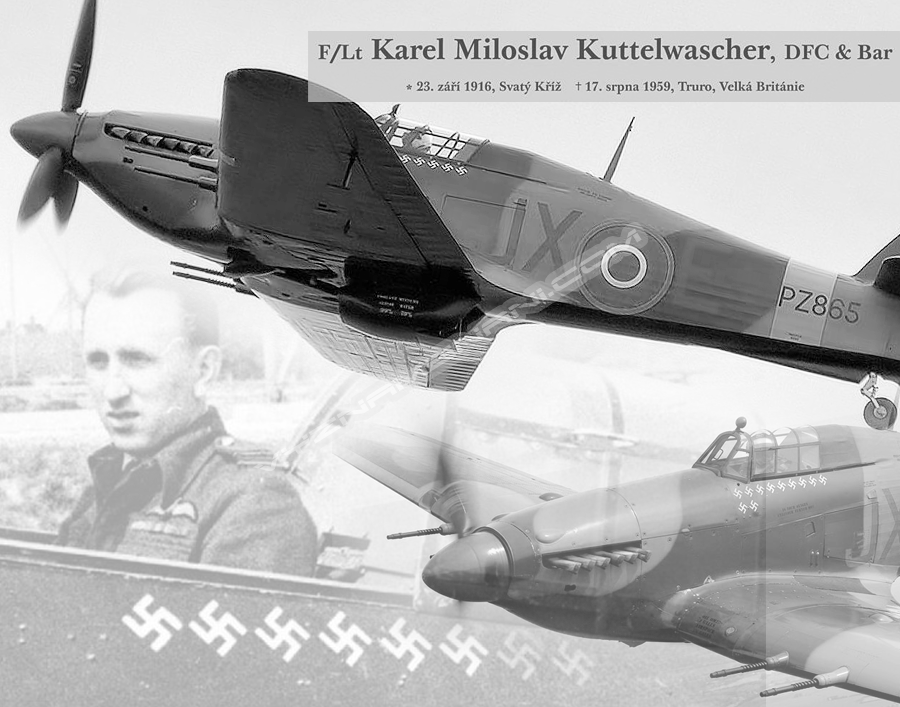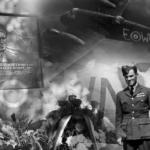
Karel Miloslav „Kut“ Kuttelwascher was born in Svaty Kriz, Czechoslovakia on 23 September 1916. He joined the Czech Air Force on 1 October 1934, aged 18. He qualified as a fighter pilot in March 1937, and was posted as a Sergeant to Letecky Pluk 4. In May 1938, Kuttelwascher transferred to Letka 32, Letecky Pluk 1 the unit was equipped with the Avia B.534 fighter biplane at Kbely airfield near Prague. Following the German occupation of Czechoslovakia in 1938 he decided to escape, getting away on the night of 13/14 June 1939, Kuttelwascher and six other Czechoslovaks escaped in a coal train to Poland, the group reported to the Czechoslovak Consulate in Krakow.
On 29 July 1939, Kuttelwascher and his group went to the Port of Gdynia where they embarked on a Swedish cargo steamship, the Kastelholm, to travel to France. On reaching France in July, he was required to join the Foreign Legion and was posted to Sidi Bel Abbès in French Algeria for army training and to learn French. But on 3 September 1939, when France and the United Kingdom declared war on Germany, all Czech airmen were transferred from the Foreign Legion to serve with the French Armée de l’Air pending the formation of a Czechoslovak air force. Kuttelwascher was sent to the fighter training base at Chartres Aerodrome, where he learnt to fly the Moräne-Saulnier M.S. 406C.1 fighter. He was transferred to a combat squadron on 17 May 1940, when he was assigned to GC III/3 at Beauvais-Tillé, the unit later moved to Cormeilles-en-Vexin, where it was re-equipped with the Dewoitine D.520C.1 fighter in June. On 22 June, remnants of GC III/3 withdrew to Algeria, the same day France surrendered.
He escaped again, this time to England, a group including Kuttelwascher travelled by train to Morocco, where Czechoslovak personnel were assembling to escape to the UK. On 9 July, they left the Port of Casablanca aboard a Scottish ferry, the Royal Scotsman, which took them to Gibraltar. On 19 July, they sailed from Gibraltar aboard the Elder Dempster Lines ship David Livingstone, reaching the UK on 5 August. He was accepted into the RAF on 14 August 1940 with a rank of Flight Sergeant. He was posted to a Czechoslovak depot at RAF Cosford, in Shropshire, and then to No. 5 OTU at RAF Aston Down, where Kuttelwascher learnt to fly the Hawker Hurricane. On 3 October 1940, he was posted to No. 1 Squadron RAF, which was equipped with the Hurricane Mk.Ia, where he fought in the latter part of the Battle of Britain. He was commissioned in October, to Pilot Officer, and in December, he was further promoted to Flying Officer. In December, the squadron was moved to RAF Northolt, and he took part in early sweeps over northern France.
On 8 April 1941, Kuttelwascher achieved his first confirmed kill in RAF service by shooting down a Bf 109 near Cap Gris Nez. In 1941 at a dance in Ruislip, Middlesex, Kuttelwascher met Beryl Ruby Thomas, and they were married in 1942. In July, 1 Squadron was relocated to RAF Tangmere in West Sussex and assigned a new role flying night intruder sorties over France, including some missions in co-operation with Turbinlite Havocs. The squadron was then operating the Hawker Hurricane Mk IIc, painted black for night flying. Each aircraft was equipped with two 45-gallon under-wing auxiliary tanks that extended its airborne time to three to 3½ flying hours and gave a range of about 900 miles (1,400 km). Armament was two Hispano-Suiza 20mm cannon on each wing. Kuttelwascher’s Hurricane was serial number „BE581“ and carried the code letters „JX-E“. It also carried a personal emblem of a yellow scythe with a red banner emblazoned „Night Reaper“.
He commenced night intruder operations over the Continent, and on the night of 1/2 April 1942, Kuttelwascher scored his first victories as a night intruder, shooting down one Ju 88 fighter-bomber and damaging a second, both near Melun, in France. On the night of 4/5 May near St-André, he shot down three He 111s within four minutes. 1 Squadron destroyed 21 enemy aircraft in three months. Of these, Kuttelwascher had shot down 15 and damaged another five. For this he was awarded the DFC and Bar and news media nicknamed him the Czech Night Hawk. On 17 February 1942, he was promoted to Flight Lieutenant. No. 1 Squadron was withdrawn from combat to convert to Hawker Typhoons, and on 8 July 1942, Kuttelwascher was transferred to No. 23 Squadron RAF at RAF Ford to continue flying night intruder missions. The squadron flew De Havilland Mosquito Mk IIs, which was equipped with H2S radar. Kuttelwascher teamed up with his navigator Pilot Officer G.E Palmer, and between August and September the pair flew six intruder missions over France and the Netherlands, but did not manage to shoot down any enemy aircraft. In September 1942, he moved to 42 Group, Maintenance Command, on liaison duties, and in October, Kuttelwascher was withdrawn from combat flying and was transferred to the Czechoslovak Air Inspectorate in London. In June 1943, he was despatched to the USA on a lecture tour by the Inspector General of the Czech Air Force in exile. Kuttelwascher spent six months in the US and Canada, primarily to try to recruit Czech and Slovak Americans and Canadians to join Czechoslovak units of the UK armed forces. He also gave lectures about the air war in Europe to the USAAF and RCAF. On his return to the UK in December 1943, he went to 32 MU, RAF St Athan in Wales, as a test pilot on various types of bomber until the end of the war.
Returning to Czechoslovakia in August 1945, he was discontented with the situation there, retiring from the Czech Air Force in May 1946, and returned to the UK. In November 1946, he joined BEA flying Vickers Vikings as a First Officer and from 1951 as a Captain. He was taken ill whilst on holiday in Cornwall in August 1959, suffering two heart attacks, from the second of which he died just before midnight on 17 August.

Kuttelwascher claimed that, while serving with the French Air Force, he destroyed or damaged several enemy aircraft. French records for that period are incomplete, but those which survive include two confirmed kills and one probable by Kuttelwascher.
Awards
- Czechoslovak War Cross 1939–1945
- Czechoslovak Medal for Bravery before the Enemy
- Czechoslovak Medal of Merit
- Commemorative Medal of Czechoslovak Army Abroad
- Croix de Guerre (France)
- DFC & Bar (British)
- The 1939-1945 Star with Battle of Britain Clasp (British)
- Air Crew Europe Star (British)
- Defence Medal (British)
- War Medal 1939-1945 (British)


Lieutenant Karel Kuttelwascher, RAF Tangmere, England, April 1942








